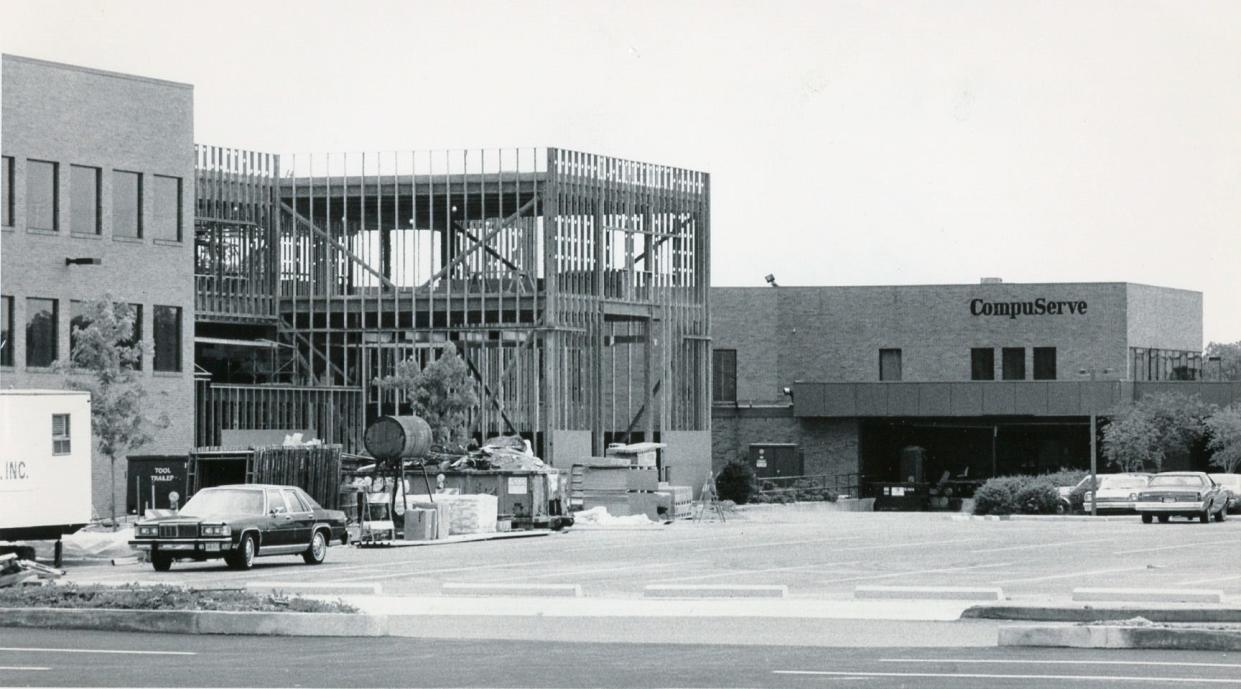CompuServe earns state historical recognition after pioneering the way to the internet

Decades before Google, Facebook and Amazon Web Services — all of which have invested billions of dollars in central Ohio — came along there was CompuServe, the first major online service that gave home computer users access to the internet and made the region the center of the tech world.
Chat forums and bulletin boards, email, widespread access to online newspapers and magazines, stock quotes and weather forecasts were among the host of products and services provided to users years before they became available elsewhere. The company, which was created in 1969, was famous for inventing the GIF digital graphics format.
At its peak, CompuServe served more than 3 million subscribers.
"I always wanted to have fun. I always wanted to make money, and I wanted to change the world," said Jeff Wilkins, who helped found CompuServe in 1969 and today serves as the executive chairman of Facilities Management eXpress software company. "Now, I haven't changed the world, but I certainly influenced it. ... I have done that multiple times. How can you have a life better than that."
Ohio historical marker honors CompuServe history

Before Christmas, the Ohio History Connection, a private nonprofit organization, placed a historical marker at CompuServe's old headquarters at 5000 Arlington Centre Blvd. in Upper Arlington in honor of the 50th anniversary of the company putting its headquarters in that building.
CompuServe operations remained at the 20,000-square-foot building until 2009 even as the company was sold to H&R Block in 1980 and then sold again as part of a three-way, $1.3 billion deal with WorldCom and AOL in 1997.
The company ultimately employed 1,300 workers in central Ohio, including 810 at its headquarters, The Dispatch reported in 2009.
The city of Upper Arlington along with GOSH Enterprises, the current owner of the building that is developing it as commercial office space, sponsored the event that drew local and state business and political leaders.
Lt. Gov. Jon Husted compared the work done by CompuServe to the development of the steam engine by opening the door to the digital pipeline of information.
"It was so foundational to the world we live in today," Husted said. "It happened right here."
"Google, (Amazon Web Services), Intel, Facebook — those are companies that would not exist if not for the seeds planted in this room," said Kenny McDonald, CEO of the Columbus Partnership, the region’s most powerful civic and business organization.
Amazon Web Services' investment in the region has hit $7 billion and will at least double by the end of the decade, said Merle Madrid, public policy manager at Amazon Web Services.
"That's all because of what started here," he said.
CompuServe history
CompuServe's history dates to 1969, before the company set up shop at Arlington Centre Boulevard.
Wilkins and his father-in-law, Harry Gard, founded CompuServe as a computer-time sharing service, operating as the computer department of Golden United Life.
Wilkins wanted to know if the company's computers, which were busy during the day serving commercial clients, could be used at night.
At the same time, hobbyists were starting to dabble in a new thing called the personal computer.
"Personal computers were kits initially. No one really made a complete machine," Wilkins said.
It started as a test with a computer club that had several hundred members, he said. The company put up databases its commercial customers were using that Wilkins figured individuals also would want to see.
"To my great surprise, people were starting to use us," he said. "That's when I thought there was something there."
CompuServe introduces first online newspaper
Wilkins knew if he really wanted to grow the service, he had to have more content.
"I thought, 'Gosh it would be great if we could get a newspaper service up on the CompuServe Information Service," he said. "That would help us drive subscriptions."
Wilkins met with the publisher of The Columbus Dispatch, John F. Wolfe, to see about accessing the newspaper, the first newspaper in the country to test the technology.
The Dispatch began transmitting newspaper content through the service that included accessing content from The Associated Press.
Who's Who of Journalism comes to CompuServe
After the success with The Dispatch, Wilkins wanted to extend the partnership to other newspapers and pitched it to the AP's board of directors made up of leaders of some of the nation's biggest newspapers, including Katherine Graham, publisher of The Washington Post.
Those leaders gathered at the CompuServe headquarters where Wilkins asked for 10 volunteer newspapers that would be willing to offer $250,000 of free advertising for each paper plus access to the AP wire service, and The Columbus Dispatch would be the first paper to participate.
"Essentially, I tried to present a picture of what it was and could become," he said. "These people are all visionaries."
The board agreed, but said Wilkins needed to offer the service to any newspaper that wanted to participate in the test.

On July 1, 1980, Wolfe, Graham and Wilkins officially launched the service to CompuServe's then 10,000 home-computer subscribers.
The news flowed into home computers at 300 words per minute and users paid $5 per hour for the service that was billed in one-minute increments.
It marked the beginning of a growth spurt for the company.
"Almost everything that ever ended up on the internet, we had in some form or another on the CompuServe Information Service," he said.
H&R Block bought CompuServe in 1980 for $20 million.
"I figured we needed capital to grow this thing," Wilkins said. "I could see what it was going to be. I was looking for a partner who could help us do that. We were growing as a company very rapidly."
In 1985, Wilkins was forced out of the company, but even then he said he continued to care about it.
"The momentum was so strong at that point in time. All the pieces were in place. The talent was great. The motivation was high. The company was going gangbusters. ... When you have that kind of nuclear energy, you can get a lot of stuff done."
mawilliams@dispatch.com
@BizMarkWilliams
The history of CompuServe
1969: Compu-Serv (the original spelling) is founded in Columbus as a computer time-sharing service by Harry K. Gard and his son-in-law, Jeffrey M. Wilkins. It is conceived as the computer department of a startup life-insurance company, Golden United Life Insurance Co., which makes the initial investment of $1 million in the company. It evolves into a stand-alone company before it opens its doors.
Jan. 15, 1970: The company opens for business as a computer time-sharing operation in a rented storefront on W. 5th Avenue, Columbus.
1973: The company moves into the firm's newly constructed 20,000-square-foot computer center and offices at 5000 Arlington Centre Blvd. in Upper Arlington.
1974: The company goes public, its shares traded under the ticker symbol CMPU on the Nasdaq stock market.
May 14, 1977: The Dispatch reports that shareholders of Compu-Serv Network Inc. recently approved changing the name of the firm to CompuServe Inc.
1977: CompuServe builds a $1.2 million computer center at 4300 Tuller Rd. near Dublin.
1979: Personal computers begin appearing, and the company starts its most widely known division, the CompuServe Information Service. It is the first service to offer electronic mail capabilities and technical support to personal-computer users. This online computer service, linking 1,200 customers by the end of its first year, is launched to augment the company's time-sharing business.
1980: CompuServe breaks new ground as the first online service to offer real-time chat with its "CB Simulator."
April 30, 1980: CompuServe shareholders approve sale of company to H&R Block.
July 1, 1980: The Dispatch begins transmitting a twice-daily "newspaper" through the service, the first newspaper in the country to test the new technology. The news flows into home computers at 300 words per minute, and users pay $5 per hour for the service, billed in one-minute increments. By the next year, The Dispatch, 10 other newspapers and the Associated Press make their news stories available to the roughly 10,000 home-computer subscribers of CompuServe.
April 1985: In a dispute with its parent company, H&R Block, Jeffrey M. Wilkins is ousted as chairman of CompuServe Inc. along with four directors, including his father-in-law, Gard.
1986: CompuServe enters the Japanese market, with a Japanese-language version of CompuServe called NiftyServe.
1989: CompuServe becomes the first major online service to open a gateway to the Internet, allowing subscribers to send and receive e-mail across the global computer network. This is the first taste of Internet connectivity for many consumers.
March 13, 1989: CompuServe's online information service for personal-computer users becomes the first such business to pass the half-million membership mark.
April 3, 1989: Plans are announced to take the service to Europe.
Dec. 20, 1990: Maurice A. Cox is named president and chief executive officer after the surprise resignation of his predecessor, Charles W. McCall.
September 1993: The company forms a strategic alliance with Metatec Inc., developed from the ashes of bankrupt Discovery Systems Inc. (which Jeffrey M. Wilkins began after leaving CompuServe). It will use Metatec technology to provide members who have compact disc-equipped computers the option of receiving multimedia information via CD. Potential content includes a graphics- and sound-enhanced version of CompuServe's electronic shopping mall, an interactive version of its magazine and multimedia extensions of some popular databases and forums.
May 1994: CompuServe erects a home page on the World Wide Web, called "a graphical interactive billboard." In an analysis of the three major online services (CompuServe, America Online and Prodigy), Fortune magazine calls CompuServe "The best of the bunch." CompuServe charges $8.95 a month for unlimited use of its basic service, but users' bills can quickly increase with use of "extended" and "premium" services.
June 2, 1994: Its ranks swelling by 80,000 accounts a month, CompuServe's information service tops 2 million subscribers.
April 28, 1995: Propelled by a boom of interest in the Internet and popular entertainment and current-events offerings, CompuServe's online computer service surges past 3 million subscribers.
June 16, 1995: Robert J. Massey is named president and CEO in the wake of Cox's resignation. Massey ramps up the company's marketing approach, saying CompuServe is being "out-hyped" and "out-marketed."
March 13, 1996: To respond to competition, CompuServe introduces Wow!, an online service for novice computer users. Despite a $20 million ad campaign, the concept never catches on. Wow! is ditched after eight months.
April 19, 1996: H&R Block spins off CompuServe as a separate publicly traded company.
Feb. 17, 1997: Massey resigns.
Sept. 8, 1997: CompuServe announces it will be acquired and split up.
Jan. 30, 1998: In a three-way deal valued at $1.3 billion, CompuServe is split and sold to AOL and WorldCom. CompuServe shareholders vote to sell the company to WorldCom, which in turn will sell CompuServe's consumer online services to America Online.
Feb. 9, 1998: America Online hands out pink slips to half its Columbus workers and says it is raising prices by 10 percent for 11 million subscribers.
Feb. 22, 1999: CompuServe launches software delivering faster service, a sleeker look and point-and-click simplicity resembling parent America Online's market-leading product. Chief Operating Officer Audrey Weil says the software, CompuServe 2000, aims for professional adults who either never had subscribed or were using another provider.
Jan. 10, 2000: America Online announces it is buying Time Warner. The deal is an aggressive bet that online delivery of media is the wave of the future.
June 30, 2009: This is the last day members can access the original CompuServe Information Service, later rebranded as CompuServe Classic. As of July 1, it no longer operates as an Internet service provider. A newer version of the service, CompuServe 2000, continues to operate.
Dispatch research by Linda Deitch
This article originally appeared on The Columbus Dispatch: CompuServe honored for laying groundwork to today's internet

